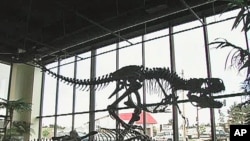The gigantic brachiosaurus … the fierce and deadly tyrannosaurus … the fast and nimble velociraptor.
There are more than 1,000 known types of dinosaurs, with an estimated 2,000 more yet to be discovered, according to paleontologists - dinosaur experts. We visit the nation's capital to learn more about the giant creatures that populated the earth millions of years ago.
The U.S. state of Colorado is an ideal destination for anyone interested in hunting for dinosaur fossils. Like Wyoming, its neighbor to the north, Colorado has its own facility devoted to restoring dinosaurs to their original form, the Rocky Mountain Dinosaur Resource Center.
"What we are trying to do is to present an incomplete specimen in a complete way. Because if you just have random bones lying around, it's hard for someone to come in and look at it and understand what the animal looked like in its entirety. And, by filling in the blanks, they see the real material that [has] been used in the reconstruction, but they also see what the animal looks like in its entirety." Anthony Maltese, curator of the center said.
The Colorado center restores about four to five dinosaur specimens every year. To ensure accuracy, it uses the actual fossilized skeletal bones to the greatest extent possible when constructing the model. But sometimes the restorers have to use silicone to fill in for the real thing. However, occasionally even they are stumped, and when that happens they have to consult other experts, many of whom are found at the Smithsonian Museum of Natural History in Washington, D.C.
Since the 19th century it has systematically collected all varieties of fossilized skeletons. The museum not only has a display area open to the public, but also has an archival collection of more than one million specimens taking up three floors. Matthew Carrano is curator of dinosaur exhibitions at the Smithsonian.
"We are a national museum, but also an international museum. Everybody really tries to come to Washington once in their lives if they live in the country. But we also get many, many thousands of (international) tourists as well," Carrano said. "It is very important to us that in our exhibition halls we reflect not just the local character of what we have but the international characters."
When he is not planning the displays, curator Carrano does his own scientific research. His latest study is this skull bone of ceratosaurus , a large predatory dinosaur. "Our ceratosaurus is a unique specimen. It is the original specimen of ceratosaurus, the very first one that was found," he explained. "The one that led paleontologist Othniel Marsh to create the name ceratosaurus."
"It's a meat-eating dinosaur. It would have lived in the Late Jurassic period about a 140, 150 million years ago. For more than a hundred years, it was the only specimen ever discovered of this dinosaur. Everyone who knew about paleontology knew about this specimen because it was the only one. In the last 20 or 30 years there have been a couple more specimens. But it's a very, very rare dinosaur," Marsh said.
Though dinosaur researchers have made giant strides in recent years, they know they have much more to learn. After all, they believe that the vast majority of dinosaur specimens have yet to be discovered.
News
Colorado Museum Makes No Bones about Restoring Dinosaurs to Original Form
update

Rocky Mountain museum is creating its own Jurassic adventure bone by bone





